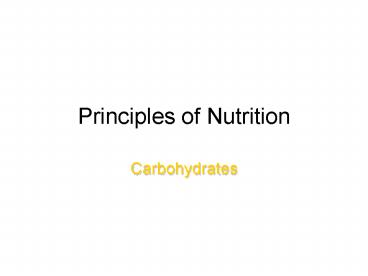Principles of Nutrition - PowerPoint PPT Presentation
1 / 23
Title:
Principles of Nutrition
Description:
fat-free or low-fat milk and ... Fitness: Ability to perform routine physical demands with the ... Byproducts are curds whey. Honey. Glu-Fru Glu Fru ... – PowerPoint PPT presentation
Number of Views:288
Avg rating:3.0/5.0
Title: Principles of Nutrition
1
Principles of Nutrition
- Carbohydrates
2
Dietary Guidelines (review)
- Healthy diet is one that Emphasizes
- Fruits and vegetables
- whole grains
- fat-free or low-fat milk and milk products
- Includes lean meats, poultry, fish, beans, eggs,
and nuts and - Is low in
- saturated fats
- trans fats
- cholesterol,
- salt (sodium)
- added sugars.
- Also Includes
- Maintain a Healthy Wt.
- Physical Activity
- Fitness Ability to perform routine physical
demands with the ability to respond to a sudden
challenge. - 30-40 minutes most days
- Other Guidelines
- Food Safety
- Moderate Alcohol Intake
3
USDAs Food Guide45-65 intake
2005
4
Fruit Group
5
(No Transcript)
6
Carbohydrate
- Energy Nutrients composed of monosaccharide.
- Carbo Carbon (CO2)
- Hydrate Water (H2O)
- Plant Photosynthesis
- Sunlight CO2 from air water
- Chlorophyll provides energy
7
Carbohydrates Sugar
- Simple- empty calories
- Monosaccharides
- Disaccharides
- Complex
- Polysaccharides
- Provide energy, energy stores, spare protein,
spare fats, heart and brain use for energy,
provide vitamins/minerals, fiber
8
Simple Sugars Monosaccharide
- Glucose (also known as Dextrose)
- Body converts starch and sugars to glucose
- used for energy by cells
- ALL carbohydrates contain Glucose (70-110 mg/dL)
- Insulin Regulates glucose in Blood.
- Fructose
- Sweetest of the Monosaccharide
- Fruct ? Fruit
- Primarily found in Honey, Fruits, Saps
- Galactose
- Makes the sugar Lactose (Found only in Milk )
- Converted by body from lactose
- 1/3-1/2 adults worldwide intolerant
9
Disaccharides
- Maltose
- Plant Sugar ? Glu-Glu
- Found when plants breakdown its starch for energy
(sprout) - Sucrose Table Sugar
- Glu Fru
- Refined from juice of Sugar Beets Sugar Cane
- Body converts Fru?Glu,
- Sucrose 2 Glucose molecules (Disaccharide)
- Lactose Milk Sugar
- GluGal
- Milk Sugar (Gal found in dairy products)
- Byproducts are curds whey
- Honey
- Glu-Fru Glu Fru ? Mix of Mono Di
- honey is sweeter that table sugar (Fruc 70)
- Has trace amounts of Vit Min, but not more
nutritious - Fruit vs. Sugar
- 1 Orange 1 Tb sugar/honey
10
Polysaccharides
- Starch ?Produced by Plants
- 100s of Glu digestion yields one glucose
- Breaks down slowly in body
- Grains
- Potatoes
- Some fruits
- Glycogen ? Produced in liver
- Used for storage in animals
- Used during sleep and physical activity
- Indigestible bits cause gas (ie. Legumes)
11
Fiber
- Cellulose plant cell walls
- Non-cellulose pectins, algae, etc.
- Lignin found in woody parts of plants
- Non-digestible ? Bulk
- Aid in water absorption
- Intestinal bacteria can break down some fibers
- Ferments in colon provides E2 for cells lining
the colon - Soluble Fibers Dissolve in H2O
- Pectins bind with cholesterol, bile salts, metals
- Insoluble Fibers Do NOT dissolve in H2O
- Apple peel
- Non-energy yielding, but contain vitamins and
minerals - Sources bran, beans and peas, whole wheat,
cereals, fruit, - Veggies - cabbage, root veggies, tomatoes,
carrots, green beans, lettuce
12
Digestion and Absorption
13
The Gastrointestinal Tract
14
Figure 5-3 Stomach Muscles
15
(No Transcript)
16
Mechanical Breakdown Peristalsis and Segmentation
17
Catabolism chemical break down (Fat)
18
The Small Intestinal Villi
19
The Small Intestinal Villi
20
Various Methods of how nutrients are Absorbed
into Intestinal Cells
21
Absorption Initial Transport of Carbohydrate
22
Figure 5-6 The Liver and its Circulatory System
23
Digestion, Absorption
- Pathway for carbohydrates
- Mouth Amylase begin break down
- Stomach Halts enzyme action (no breakdown of
Carbs) - Small Intestines
- Pancreatic Amylase continues breakdown
- Disaccharides ? Monosaccharides
- Absorption takes place active transport
- Blood ? Liver (glucose and glycogen)
- Large Intestines (Colon) ? Bacteria breakdown
some fiber.






























![[PDF] Guiding Principles of Natural Horse Care: Powerful Concepts for a Healthy Horse Kindle PowerPoint PPT Presentation](https://s3.amazonaws.com/images.powershow.com/10078377.th0.jpg?_=20240713083)
